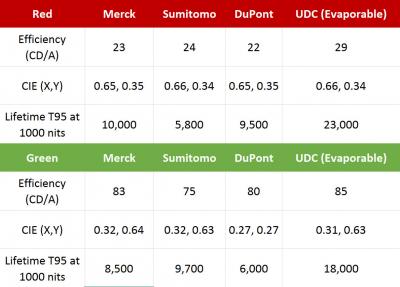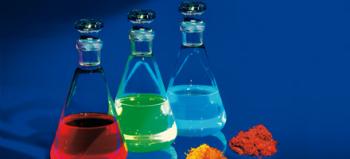UBI: the OLED emitter material market grew 17% in 2015 as producers increase capacity and change material suppliers
According to UBI Research, the market for OLED emitting materials grew 17% from 2014 to 2015. Universal Display (the top supplier in terms of revenues), Dow Chemical and LG Chem saw a decrease in sales while Novaled, Idemitsu Kosan and Samsung SDI saw improved revenues.

Samsung Display is the largest OLED producer by far, and so when it changes suppliers it changes the whole market. UBI says that in 2015 Idemitsu Kosan, the second supplier in terms of revenue started delivering blue fluorescent emitters to Samsung Display, and also enjoyed the ramp-up in OLED TV production by LGD.
OSRAM to start using UDC's PHOLEDs in future OLED lighting panels
Universal Display announced that it signed a collaboration and evaluation agreement with OSRAM. OSRAM will begin to sample UDC's PHOLED OLED materials for OLED lighting applications.

OSRAM is mostly focused on OLED for the automotive market, and the company recently announced a five-year strategic plan that includes a â¬2 billion investment in current and future lighting applications - which includes OLEDs for the automotive market. The company's CEO considers OLED important for some niches, but too expensive for general lighting.
Universal Display reports a weak quarter and a soft guidance for 2016
Universal Display reported their financial results for Q4 2015 - which were lower than expected. Revenues reached $62.3 million (including $30 million from SDC in licensing revenue) and the operating income was $26.6 million. Net income was $18.1 million up from $13.1 million in Q4 2014.

In 2015, UDC generated $191 million in revenues - exactly the same as in 2014. Material sales were $113.1 million and the net income was $14.7 million (down from $41.9 million in 2014, because of a large inventory write-down earlier in 2015). In 2015, UDC generated $113.6 in cash - more than double 2014's operating cash flow of $47.3 million. The company has $395.5 million in cash and equivalents.
UDC's evaporable emitters still outperform the best soluble materials
A few weeks ago we posted about Merck's soluble OLED material performance, and today we have some more data from the OLED Association. In the table below you can see how Merck's, Sumitomo and DuPont's soluble materials compare to UDC's evaporable OLED's materials.

As you can see, for the red material, evaporable OLEDs have a clear lead in lifetime and efficiency. For the green material that efficiency gap has pretty much closed, while the lifetime of the evaporable materials are still about double than the best soluble materials.
Merck reveals the efficiency and lifetime of their red and green soluble phosphorescent emitters
In January 2013, Merck said that the performance gap between soluble and evaporable OLED emitters is closed - at least in the lab. Earlier this month at the OLED World Summit the company revealed the development results of their phosphorescent materials, comparing them to UDC's materials (as published on UDC's website).

Merck's red emitter features an efficiency of 19.1cd/A, a lifetime (L90) of 5,900 hours and the CIE is (0.66, 0.34). UDC's red material features an efficiency of 29 cd/A and a lifetime of 23,000 hours. Merck's green material features an of 76.4cd/A, a lifetime of 5,200 hours, and the CIE is (0.32, 0.63). UDCs green features an efficiency of 85 cd/A and lifetime of 18,000 hours, The CIE is similar (0.31, 0.63).
Reports say Apple aims to adopt OLEDs in iPhones in 2018, in talks with suppliers to secure capacity
In the past few weeks I have read dozens of stories regarding Apple and their display choice for future iPhones. Some reports say that they aim to adopt OLEDs in their future iPhones starting in 2017, some say Apple decided to remain with LCDs... One thing for sure - the 2016 iPhones will use an LCD and not an OLED.

One of the major reasons for that is that Apple sells around 200 million iPhones in a year - and there's simply not enough OLED production capacity for that. New reports from Japan say that Apple does want to switch to OLEDs - and is in talks with suppliers to secure the capacity and increase the lifetime and performance of OLEDs.
Universal Display reports financial results for Q3 2015
Universal Display reported their financial results for Q3 2015 - with revenues reaching $39.4 million (up from $32.9 million in Q3 2014) and net income of $7 million (up from $4.3 million in Q3 2014).

UDC generated $5.4 million in the quarter - and the company forecasts that free cash flow will reach $100 million in 2015, double that of 2014. UDC has $362 million in cash and equivalents. The revenue guidance for 2015 was maintained at $200 million (but they narrowed the upside and downside to 3%).
Researchers develop an efficient deep-blue PHOLED
Researchers at the University of Michigan developed a new deep-blue energy-efficient phosphorescent OLED (PHOLED) emitter. The researchers say that this is the brightest deep-blue PHOLED ever reported - in fact it is about 10 times brighter than previous deep-blue PHOLEDs. The lifetime of this material is still very low, and future research will attempt to stabilize the molecule.

The new emitter is based on a N-heterocyclic carbene iridium-III complex molecule. This is an efficient compound because its design reduces the chances that light-emitting excitons will either get lost as heat or destroy the compound itself. This research is sponsored by Universal Display Corporation and the U.S. Air Force.
ASU researchers develop a high-quality OLED lighting device that uses a white emissive material
Researchers from Arizona State University (ASU) are developing high-qualify OLED lighting devices that emit no UV light. Such OLEDs will be particularly useful in museums, art galleries and similar places, since UV light inhibits the human eye in clearly discerning color variations and the texture of objects.

The researchers recently received a $875,000 grant from the US DoE to expand the research. The team is collaborating with Universal Display to develop OLEDs that use a single emissive material to create white light - and not a white OLED device that uses a combination of red, green and blue emissive materials (or yellow and blue).
UDC reports disappointing results for Q2 2015
Universal Display reported their financial results for Q2 2015. UDC generated $58.1 in revenues (down from $64.1 million in Q2 2014) and saw a net loss of $11.8 million (due to a $33 million green host inventory write-down).
Material sales were $24.3 million (down 32% from Q2 2014) and royalties and license fees were $33.7 million (up from $28.1 million in Q2 2014) - out of which SDC paid $30 million. Excluding the inventory write-down, operating income was $28.5 million and the company generated $28.2 million in the quarter and now has $356.2 million in cash and equivalents.
Pagination
- Previous page
- Page 12
- Next page



